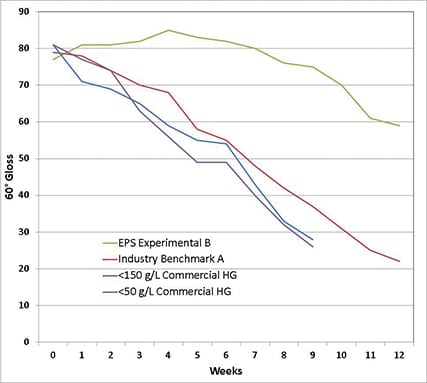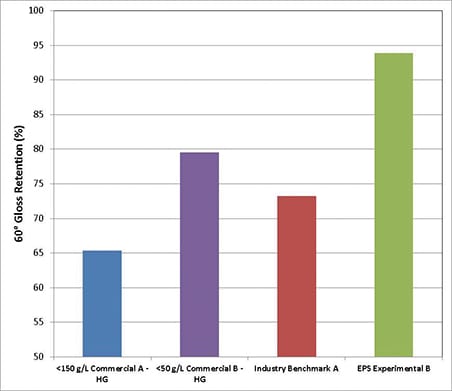By Robert W. Sandoval, Tyler J. Bell, Mary Jane Hibben, and Mike Wildman, Engineered Polymer Solutions
Maximizing the gloss retention and dirt-pickup resistance (DPUR) is a key requirement for many exterior architectural coatings and is a target that many commercial paints struggle to meet. In this study, the exterior durability of a range of resins and paints was evaluated. In particular, for DPUR, an accelerated testing method is compared to exterior exposure data collected from Midwest and West Coast test fence locations. The location of the exterior exposure is shown to have a large impact on the ability to discriminate DPUR performance between paints/resins in a short period of time. Paints that have a similar DPUR performance when they are exposed at the Midwest location show much larger differences when they are exposed at the West Coast location in as little as three to four months. Several accelerated DPUR testing protocols (one-week procedure) were also conducted, and while many samples perform relatively similarly, some differences that depend on the testing protocol are noted. These results underscore the impact that the exterior exposure location/testing protocol has on DPUR. In the second part of this study, the gloss retention was evaluated by an accelerated QUV-A protocol and compared to exterior exposures. The accelerated QUV-A method can discriminate between formulas in a shorter period of time (four to eight weeks) and tends to agree well with longer-term exposures (over one year) from the West Coast.
Introduction
The primary function of exterior architectural coatings is to protect a substrate and withstand exposure to weather. With a wide variety of weather conditions in the United States, a coating must withstand many harsh conditions, including freeze/thaw, rain, ultraviolet (UV) exposure, wind, smog, and ice/hail. Many methods have been developed to test for the variety of conditions that an exterior coating may experience. Accelerated laboratory tests are popular due to the shorter time that it takes to run these tests. However, the “gold standard” for many coating manufacturers is to expose the coating outside in regions with extreme weather conditions. Typically, multiple years of exterior exposure are desired for new products, which is not always feasible during product development.
Dirt-pickup resistance (DPUR) is typically defined as the ability of a coating to resist dirt, which over the course of time, darkens the film and can result in an uneven appearance.1 Dirt can be transported onto the coating by particulates in the air (e.g., smog), and a high level can accelerate the darkening of the film. Accelerated testing is typically done by using dirt standards (e.g., iron oxide slurries, carbon black slurries, or dry dirt particulate) that are applied to a panel and removed by washing, tapping, or wiping off the panel which is then evaluated for color change. Both resin composition and paint formulation can impact the DPUR of a coating. For example, a higher polymer binder glass transition temperature (Tg) and minimum film forming temperature (MFFT) can improve the DPUR. However, stricter VOC regulations that indirectly limit how hard resins can be practically made and maintain an acceptable MFFT or low-temperature coalescence have negatively impacted DPUR performance for which new polymer innovations are needed.
Gloss retention is another key exterior durability property that is commonly evaluated. As coatings are exposed to UV radiation, film degradation occurs that can roughen the coating surface and reduce the gloss of the film.2,3 For a consumer, gloss retention is most noticeable when multiple sides of a building are painted that receive different levels of UV light (e.g., a south-facing wall versus a north-facing wall), resulting in different sheens of gloss on different sides of the building. In addition to film degradation, gloss reduction may indicate other failure mechanisms that may occur upon further aging.
As described previously, accelerated testing procedures are popular because they can accelerate formulation development. However, once a resin or formulation is complete, exterior exposure testing is needed to confirm laboratory results. One challenge in exterior exposure testing is the wide range of environments in the United States. Coatings placed in areas with lower levels of air pollution and smog may show little variability between formulations whereas dramatic differences can be observed when coatings are tested in areas with high levels of air pollution.
In this study, DPUR and gloss retention accelerated testing protocols were compared to exterior exposure data from the Los Angeles region and Midwest regions. The location of the exterior exposure is shown to impact the DPUR and is greatly accelerated in Los Angeles. Greater differentiation is seen between paints placed for exterior exposure in Los Angeles. Samples exposed and tested on different substrates show some variability in the DPUR but show similar rankings.
Gloss retention testing demonstrates that an experimental resin shows superior gloss retention in both accelerated testing and longer-term exposures than an industry benchmark resin. The industry benchmark resin and commercial high gloss benchmark paints showed gloss loss after just one week in QUV testing and gloss loss after only four months of exposure in Los Angeles. Although a direct correlation between QUV testing and exterior exposures is not obvious in this series, a qualitative assessment can be made with accelerated testing to predict long-term performance.
Experimental
Materials
Several experimental resins were used in this study. Three experimental resins were selected: two all-acrylic high gloss resins (Experimental A and Experimental B) and an all-acrylic resin (Experimental C) intended for flat through semi-gloss paints. An industry benchmark high gloss resin (IB A) was also used in this study for comparative purposes. A wide variety of leading national and regional commercially available high gloss (Comm. HG #) and semi-gloss (Comm. SG #) paints were also tested.
Exterior Exposure Testing
Figure 1 shows the location of EPS North America exposure testing sites. This study was completed with samples exposed in Los Angeles, CA and Marengo, IL. Los Angeles was chosen due to the higher levels of air pollution and sunlight (UV) that is received in the region, the low levels of rain/moisture, and warmer temperatures. Comparatively, in the Midwest, Marengo, IL (northwest of Chicago) has lower levels of air pollution, lower temperatures, and more moisture. Panels were placed facing South at 45° to maximize UV exposure. This procedure was used for both DPUR testing and gloss retention. Although panels were also placed in Fort Myers, FL, this particular study did not focus on that region.
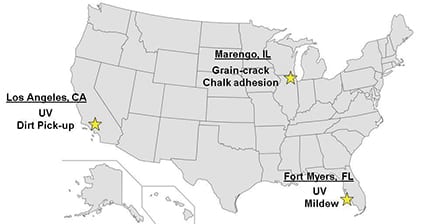
FIGURE 1—EPS North America exterior durability exposure sites and primary testing that occurs at each site.
Accelerated Dirt-pickup Resistance Testing
For accelerated DPUR testing, several procedures were run to compare testing methods. Three sets of paints were drawn down on various substrates with a 3 mil bird bar and dried overnight. The panels were placed in either a QUV chamber for one week which cycles between 8 h of UV-A and 4 h of condensation (according to ASTM G154) or outside facing south at 45° in Los Angeles, CA or Marengo, IL. After the UV exposure, samples were placed in a 60°C oven for 30 min. A dry dirt particulate was applied onto a portion of the panel for 30 min in the oven, after which excess dirt was tapped from the panel. The ΔE was calculated by measuring the color difference between the stained and unstained portion of the panel, with a higher ΔE value indicating higher levels of dirt pickup.
Accelerated Gloss Retention Testing: QUV-A
Accelerated gloss retention testing was performed by drawing down paints with a 3 mil bird bar on aluminum panels and allowing them to dry overnight. The panels were placed in a QUV chamber which cycles between 8 h of UV-A (340 nm) and 4 h of condensation (according to ASTM G154). The initial 60° gloss was recorded, and panels were measured for gloss each week for up to 2000 h (~12 weeks). Panels were removed from the chamber to measure gloss during the UV cycle.
Results
Long-term Dirt-pickup Resistance Testing: Exposure Location
The first evaluation compared exterior exposure testing locations. Figure 2 compares six paints exposed in Marengo and Los Angeles in whites and a tinted base. The initial panels for both sites are shown, along with photos after 12 months. When comparing the 12-month photos between each site, some noticeable differences in DPUR are observed. Whereas most of the panels are relatively equal when exposed in the Midwest for DPUR, there is significantly more variation between several paints when exposed in Los Angeles. The second paint on the panels showed poorer DPUR compared to the other samples. This underscores the significance the exposure testing location has on the DPUR results. Additional longer-term DPUR data in this article will focus on exposures from Los Angeles.
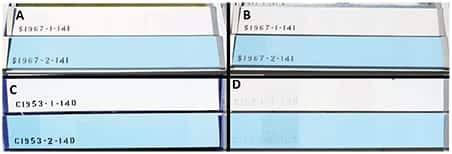
FIGURE 2—Dirt-pickup comparison of exterior exposure sites. Six paints were applied to 6 in. x 6 in. sections on each board and exposed in Marengo, IL: initial (A) and 12 month (B) and Los Angeles, CA: initial (C) and 12 month (D).
Long-term Dirt-pickup Resistance Testing: Commercial Benchmarking
A series of leading national and regional commercially available high gloss (Comm. HG #) and semi-gloss (Comm. SG #) paints was tested and compared to experimental resins. Initial and 10-month Los Angeles exposure panel photos are shown in Figure 3 (high gloss) and Figure 4 (semi-gloss), and the layouts are identified in Tables 1 and 2. As can be seen in the photos, the experimental resins perform well and there is wide variability among the different commercial benchmark paints.
Accelerated Dirt-pickup Resistance Testing
In addition to the long-term exposure testing, several accelerated dirt-pickup resistance testing protocols were evaluated. Figure 5 shows the ΔE values for accelerated DPUR testing for various high gloss paints that were exposed to UV at different sites. Note that these samples were only exposed outside for one week (i.e., little to no dirt pickup occurred on the panel during exposure; dirt was added for accelerated testing). It is apparent that the location of the UV exposure impacts the ΔE in the accelerated DPUR test. In general, the QUV chamber testing shows cleaner overall panels, whereas panels exposed in LA showed higher levels of dirt. Panels exposed in Marengo, IL showed the least variation. Industry Benchmark A had the highest level of dirt pickup. Experimental Resin B (in the same paint formula) shows the lowest levels of dirt pickup among all samples. Commercial paint B showed the most variability among exposure procedures.
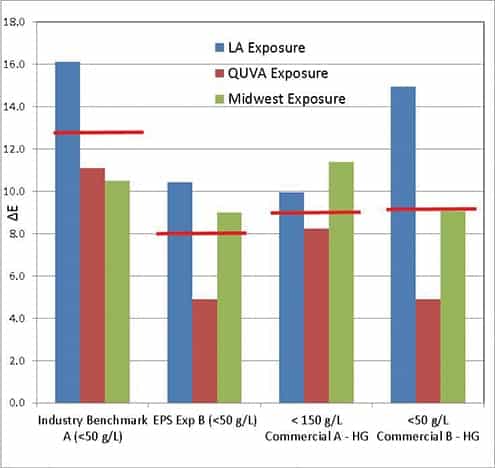
FIGURE 5—Impact of UV source on accelerated dirt-pickup resistance testing of paints. The red line indicates the average ΔE for all exposure methods for each paint.
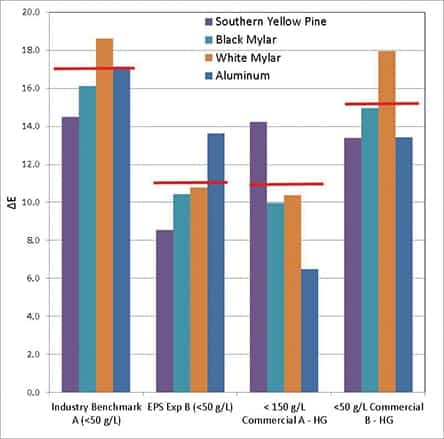
FIGURE 6—Accelerated dirt-pickup resistance testing by substrate. The red line indicates the average ΔE for all substrates in each sample.
Additionally, different substrates were evaluated to examine the impact on accelerated DPUR testing. For samples exposed in Los Angeles, four different substrates were used. Figure 6 shows the ΔE values for the various substrates. Drawn down on aluminum, the < 150 g/L commercial paint shows the best DPUR performance. However, on southern yellow pine, it was the second worst performer. While variability does exist between substrates, the average ΔE for all the substrates for each sample (red line in the figure) gives a clearer overall picture of the DPUR than simply looking at results on one substrate.
On each substrate, the paints were compared and ranked for DPUR performance. Table 3 shows the rank of each sample from Figure 6 along with the overall average ranking (accelerated QUV testing on aluminum is also included in Table 3). The competitive resin ranked last among all substrates. The Experimental Resin B showed equal to better performing DPUR than Commercial Paint A, with no less than a 2 ranking. Commercial A had several 3 rankings, as did Commercial B. Given the higher VOC level of Commercial A, the DPUR performance is not surprising, although the Experimental Resin B matches the performance at a lower VOC. While the absolute ΔE value varies depending on substrate, the samples show similar ranking.
Gloss Retention
Figure 7 compares Industry Benchmark A, two industry leading commercial high gloss paints, and Experimental Resin B for accelerated gloss retention in the QUV chamber. Gloss retention (represented by 60° gloss measurements) by resin type in the same paint formulation shows very different results. The experimental resin showed 100% retention up through approximately eight to nine weeks whereas the industry leading resin started to lose gloss after just one week. After 12 weeks of exposure, the gloss retention in the Experimental B is higher than Industry Benchmark A. Interestingly, the two industry leading <150 g/L and < 50 g/L commercial paints began to lose gloss after one week in QUV and steadily dropped, matching the behavior of Industry Benchmark A.
Panels of the same paints/resins in Los Angeles show similar rankings (Figure 8). After only four months of exposure, Experimental B outperformed Industry Benchmark A and the two industry leading commercial paints, retaining over 90% of its gloss. Long-term gloss retention testing is complicated by the dirt pickup that can also occur when being exposed long term, which in addition to its appearance, can also impact the gloss. So while there is not an obviously direct quantitative correlation between QUV and long-term exposures, qualitatively, the trends are apparent.
Summary
In summary, this study compared dirt-pickup resistance and gloss retention testing methods, both accelerated techniques and long-term exterior testing. For DPUR, samples exposed on the West Coast near Los Angeles showed more differentiation between paints in a series versus being exposed in Marengo, IL. The experimental resins show outstanding DPUR performance compared to the commercial benchmarks. This study demonstrates that the location significantly impacts the DPUR performance and that new formulas can be screened quicker at the Los Angeles test fence site. When comparing accelerated DPUR testing techniques, exposing the panels to different environments was also shown to impact performance, however, the general trend between samples held.
Gloss retention testing demonstrated that the Experimental Resin B showed superior gloss retention in both accelerated testing and longer-term exposures. An industry benchmark resin and two commercial high gloss benchmark paints showed gloss loss after just one week in QUV testing and gloss loss after only four months on the test fence. While a direct correlation between QUV testing and exterior exposures is not obvious, a qualitative comparison of paint samples can be made with accelerated testing to predict long-term performance.
Acknowledgments
The authors wish to thank the following members of the EPS Architectural Group for help with preparing resin, paint, and exposure samples: Andrew Balgeman, Pat Lutz, Jacob Bolton, Paige Booth, James Harris, Tom Regelin, Audrey Plyler, and DJ Christensen.
References
- Vandezande, G., “Improved Dirt Pickup Resistance Critical to Future Coating Innovation,” Paint & Coatings Industry, May 1, 2008.
- Wicks, Z.N. Jr., Jones, F.N., Pappas, S.P., and Wicks, D.A., Organic Coatings Science and Technology, John Wiley & Sons, NJ, 2007.
- Hare, C.H., Protective Coatings: Fundamentals of Chemistry and Composition, Society for Protective Coatings, PA, 1998.






